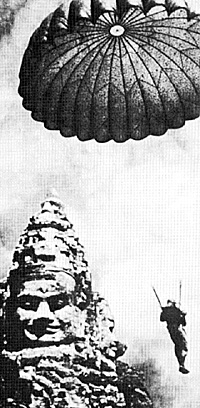 It started out as a place of redemption for the French Army, or at
least one of honor. For close to five years French soldiers sat back and
did nothing as the Japanese took over Indochina and fought the native
Viet Minh. Finally, the French took up arms against the Japanese in 1945.
It started out as a place of redemption for the French Army, or at
least one of honor. For close to five years French soldiers sat back and
did nothing as the Japanese took over Indochina and fought the native
Viet Minh. Finally, the French took up arms against the Japanese in 1945.
For two months Free French forces held a broad valley in northern Vietnam called Dien Bien Phu against repeated Japanese assaults. No one outside Southeast Asia heard much about the battle. Few have forgotten the battle that took place when the French returned.
With the Japanese defeated, the war in Indochina switched to one between the French and the communist Viet Minh. While the world's eyes turned to Korea in the early 1950's, the battle raged on in Indochina. The Viet Minh were no mere mob of raggedy guerillas -- by 1953 they boasted seven fully-equipped divisions and one Soviet- pattern artillery division. The end of fighting in Korea in July 1953, promised to free up even more equipment and instructors for the Viet Minh troops training in southern China.
Dien Bien Phu, near the Vietnamese-Laotian border about 100 miles south of the Chinese border, fell into communist hands in November 1952, when a Laotian infantry battalion garrisoning the area fell back into Laos without a fight. The valley, noted as one of Asia's top opium collection and processing centers, was occupied by the 148th Independent Regiment and soon became a major source of rice and money for the revolutionaries.
A year later, two "French" parachute battalions (most of the troops were Vietnamese) took the valley back. This time, French generals boldly told the Paris papers, they were back to stay. A few weeks later, the French rejected an offer by Ho Chi Minh for a negotiated settlement to the war. The Viet Minh would need the economic power of the Dien Bien Phu drug trade if they were to continue the war.
None of the French commanders expected to have much trouble when the battle began. An "air-land base" was prepared by the Expeditionary Corps complete with a handful of tanks and 28 artillery pieces. The French anticipated a big battle, perhaps of several weeks duration, but believed that their forces were superior and would triumph. The commander-in-chief in Indochina made these expectations explicit in a directive months in advance. Those subordinates who harbored doubts remained silent in public, projecting only optimism while confining themselves to elliptical warnings in secret memoranda.
There was reason for optimism. In December 1952, the "air-land base" at Na-San, about 70 miles northwest of Dien Bien Phu, had been besieged by the Viet Minh 308th and 312th Divisions. The defenders beat back repeated human wave assaults -- then in vogue in their Chinese sponsors' campaign in Korea -- at a terrible cost to the attackers. Na-San was evacuated in August 1953, because of the drain on troops and air transport. Without Na-San a new government center was needed for the pro-French T'ai Tribal Federation. Dien Bien Phu was selected.
To Save Dien Bien Phu The French in Indochina
-
Introduction
Dien Bien Phu Efforts
US Naval and Air Support
French Plans
Operation Vulture to the Fall
Large Map of Overland Relief (slow: 107K)
Back to Table of Contents: CounterAttack # 3
To CounterAttack List of Issues
To MagWeb Master Magazine List
© Copyright 1991 by Pacific Rim Publishing Company.
This article appears in MagWeb.com (Magazine Web) on the Internet World Wide Web.
Other articles from military history and related magazines are available at http://www.magweb.com